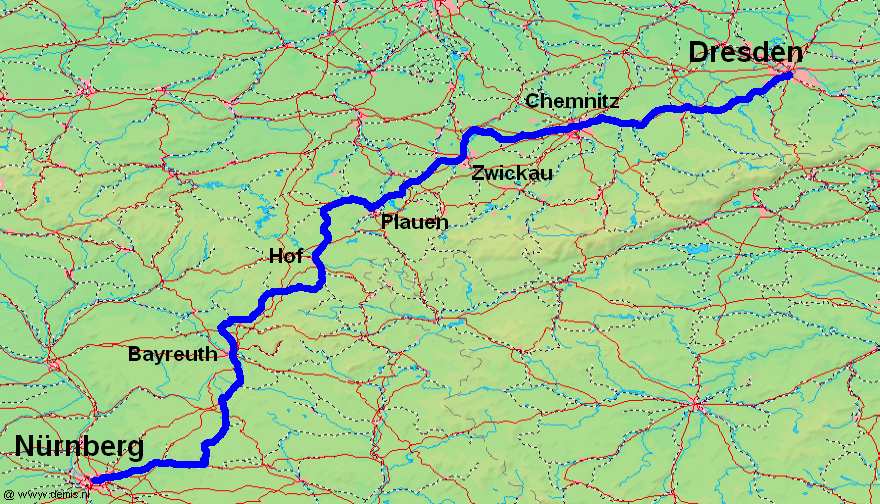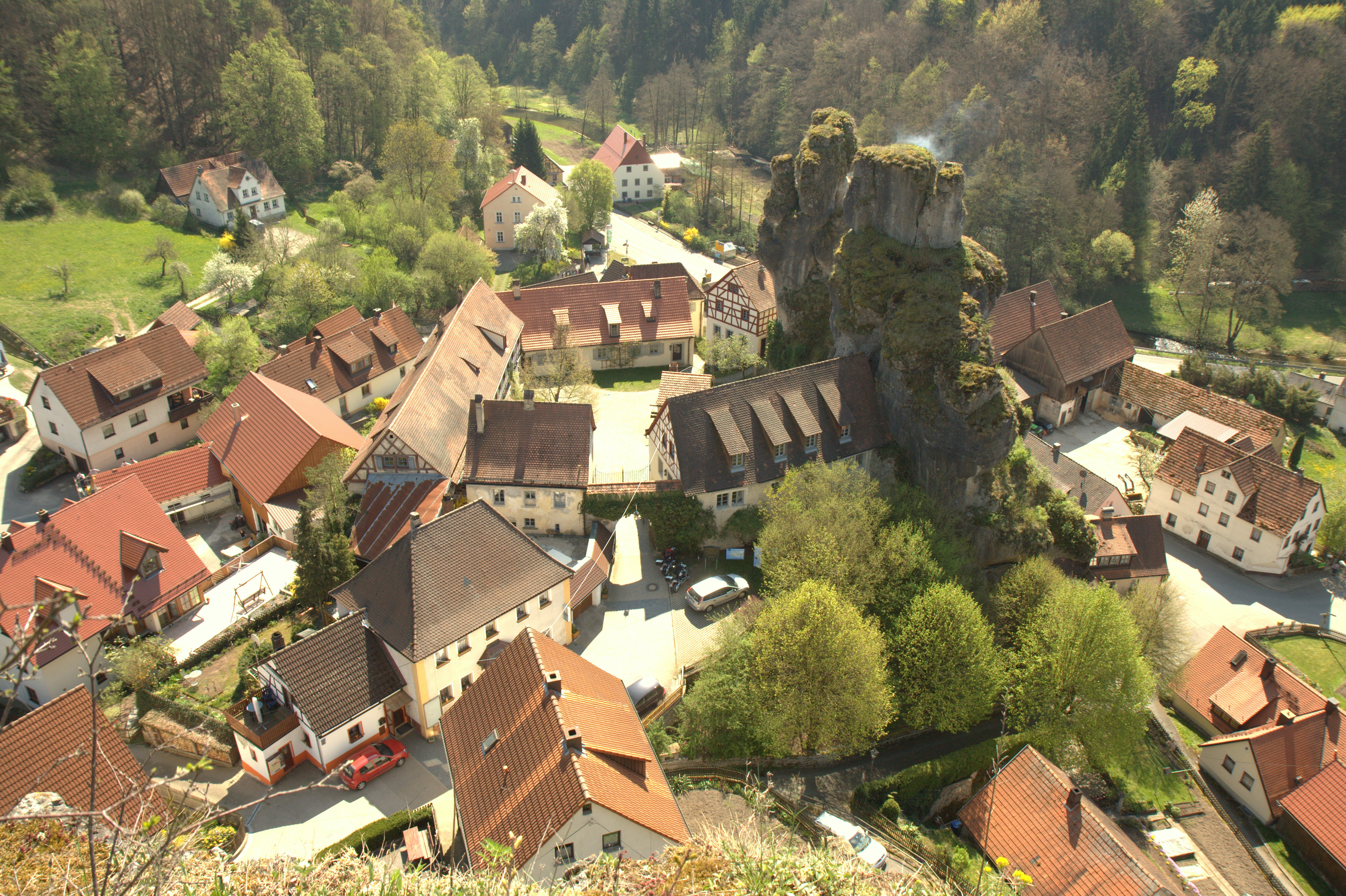|
Franken-Sachsen-Express
Saxon-Franconian trunk line (german: Sachsen-Franken-Magistrale) is a modern term for a double-track railway route between the German cities of Dresden and Nuremberg. It is 390 kilometres long and currently electrified from Dresden to Hof. The concept of the Saxon-Franconian trunk route was developed in the transport policy debate in the 1990s during consideration of direct rail services connecting Dresden and Görlitz with Karlsruhe and Oberstdorf. The term is not traditionally used in relation to the railway lines now described by it. Route The route runs from Dresden to the southwest through the Ore Mountain Foreland (''Erzgebirgsvorland''), running from Dresden to Zwickau parallel with the Ore Mountains. Between Plauen and Hof it passes through the Vogtland. The route then cuts through the Fichtelgebirge range, the Franconian Jura and Franconian Switzerland. Dresden–Hof See: *Dresden–Werdau railway *Leipzig–Hof railway Hof–Nuremberg See: * Weiden–Oberkotzau ... [...More Info...] [...Related Items...] OR: [Wikipedia] [Google] [Baidu] |
Dresden–Werdau Railway
The Dresden–Werdau railway is an electrified, double-track main line in the German state of Saxony. It runs from Dresden Dresden (, ; Upper Saxon: ''Dräsdn''; wen, label=Upper Sorbian, Drježdźany) is the capital city of the German state of Saxony and its second most populous city, after Leipzig. It is the 12th most populous city of Germany, the fourth larg ... via Freiberg (Sachs) station, Freiberg, Chemnitz Hauptbahnhof, Chemnitz and Zwickau Hauptbahnhof, Zwickau to Werdau wye, where it joins the Leipzig–Hof railway, Leipzig-Hof railway. The line was opened in several sections and its first section from Werdau to Zwickau was opened 1845, making it one of the List of the first German railways to 1870, oldest railways in Germany. The Dresden–Tharandt section was completed in 1855, the Chemnitz–Zwickau section followed in 1858, the line was extended from Tharandt to Freiberg in 1862 and the section from Chemnitz to Flöha was opened as part of the Annaberg-Buchh ... [...More Info...] [...Related Items...] OR: [Wikipedia] [Google] [Baidu] |
Nuremberg–Cheb Railway
The Nuremberg–Cheb railway is a 151 km long, non-electrified main line, mainly in the German state of Bavaria. It runs from Nuremberg via Lauf an der Pegnitz, Hersbruck, Pegnitz (city), Pegnitz, Speichersdorf, Kirchenlaibach, Marktredwitz and Schirnding to Cheb in the Czech Republic. The route is also known as the ''Right'' (bank of the) ''Pegnitz (river), Pegnitz line'' (german: rechte Pegnitzstrecke or the ''Pegnitz Valley Railway'' (''Pegnitztalbahn''). It was built as the ''Fichtelgebirge, Fichtel Range Railway'' (''Fichtelgebirgsbahn''). The Nuremberg–Schnabelwaid section of it is part of the Saxon-Franconian trunk line (''Sachsen-Franken-Magistrale''). History The line was originally intended to provide a direct link between Nuremberg and Bayreuth, adding to the Bayreuth–Neuenmarkt-Wirsberg railway, Bayreuth–Neuenmarkt-Wirsberg branch line opened in 1853 from the Bamberg–Hof railway, Bamberg–Hof section of the Ludwig South-North Railway. Since the route via ... [...More Info...] [...Related Items...] OR: [Wikipedia] [Google] [Baidu] |
Bayreuth–Neuenmarkt-Wirsberg Railway
The Bayreuth–Neuenmarkt-Wirsberg line is a single-track main line railway in the German state of Bavaria. It is an important section of the so-called ''Saxon-Franconian trunk line'' from Dresden to Nuremberg. The line was opened in 1853 and is one of the oldest railways in Germany. History It was the first Bavarian railway line to be built and leased to the state. That is, it was financed by the city of Bayreuth and the line was built and subsequently leased by the Bavarian government. The route from Neuenmarkt to Bayreuth was opened on 28 November 1853 by the Royal Bavarian State Railways as one of the first branch lines of the Ludwig South-North Railway. In 1905 the line was nationalised. Operations The line connects with the Bamberg–Hof line in Neuenmarkt-Wirsberg, leading to Bamberg and Hof. Services are operated approximately hourly between Bayreuth and Bamberg by agilis. In the past trains from Bayreuth had to change direction in Neuenmarkt-Wirsberg to continue up ... [...More Info...] [...Related Items...] OR: [Wikipedia] [Google] [Baidu] |
Bamberg–Hof Railway
The Bamberg–Hof railway is a 127 kilometre-long main line that runs through Bavaria in southern Germany. The line runs from Bamberg via Lichtenfels, Kulmbach, Neuenmarkt- Wirsberg and Münchberg to Hof. The section from Hof to Neuenmarkt now forms part of the Saxon-Franconian trunk line. History The line is part of the Ludwig South-North Railway from Lindau to Hof. It was built in 3 stages between 1846 and 1848 by the Royal Bavarian State Railways. Its expansion into a double-tracked railway followed in 1891 and the line was electrified from Bamberg to Lichtenfels and beyond that via the Franconian Forest Railway to Saalfeld on 10 May 1939. In the 1960s the second track was lifted between Marktschorgast and Stammbach due to the lack of traffic. Opening dates * 15 February 1846: Bamberg–Lichtenfels * 15 October 1846: Lichtenfels–Neuenmarkt-Wirsberg * 1 November 1848: Neuenmarkt-Wirsberg–Hof Description of the route Shortly after the route leaves Bamberg station the b ... [...More Info...] [...Related Items...] OR: [Wikipedia] [Google] [Baidu] |
Franconian Switzerland
Franconian Switzerland (german: Fränkische Schweiz) is an upland in Upper Franconia, Bavaria, Germany and a popular tourist retreat. Located between the River Pegnitz in the east and the south, the River Regnitz in the west and the River Main in the north, its relief, which reaches 600 metres in height, forms the northern part of the Franconian Jura (''Frankenjura''). Like several other mountainous landscapes in the German-speaking lands, e.g. Holstein Switzerland, Märkische Schweiz, or Pommersche Schweiz, Franconian Switzerland was given its name by Romantic artists and poets in the 19th century who compared the landscape to Switzerland. Franconian Switzerland is famous for its high density of traditional breweries. Name The region was once called ''Muggendorfer Gebürg'' (''Muggendorf hills''). The first tourists arrived during the age of Romanticism. Two law students of Erlangen University, Ludwig Tieck and Wilhelm Heinrich Wackenroder have been credited as "discoverers" o ... [...More Info...] [...Related Items...] OR: [Wikipedia] [Google] [Baidu] |
Zwickau
Zwickau (; is, with around 87,500 inhabitants (2020), the fourth-largest city of Saxony after Leipzig, Dresden and Chemnitz and it is the seat of the Zwickau District. The West Saxon city is situated in the valley of the Zwickau Mulde (German: ''Zwickauer Mulde''; progression: ), and lies in a string of cities sitting in the densely populated foreland of the Elster and Ore Mountains stretching from Plauen in the southwest via Zwickau, Chemnitz and Freiberg to Dresden in the northeast. From 1834 until 1952, Zwickau was the seat of the government of the south-western region of Saxony. The name of the city is of Sorbian origin and may refer to Svarog, the Slavic god of fire and of the sun. Zwickau is the seat of the West Saxon University of Zwickau (German: ''Westsächsische Hochschule Zwickau'') with campuses in Zwickau, Markneukirchen, Reichenbach im Vogtland and Schneeberg (Erzgebirge). The city is the birthplace of composer Robert Schumann. As cradle of Audi's forerunner ... [...More Info...] [...Related Items...] OR: [Wikipedia] [Google] [Baidu] |
Werdau Arc Triangle
Werdau () is a town in Germany, part of the Landkreis Zwickau in Saxony. It is situated on the river Pleiße, 8 km from Zwickau. The town was mentioned as early as 1304, and in 1398 it was purchased by Frederick, then margrave of Meissen, who afterwards became Elector of Saxony. The textile industry was the dominant industry in Werdau since the 14th century. The industrial character of the town further increased in the 20th century with the large-scale truck production by the IFA conglomerate. Both industries were not competitive after the German reunification in 1990, leading to a sharp deindustrialisation. The character of the town changed dramatically over the last 20 years after almost all factories were demolished and the characteristic East-German residential Plattenbauten were scaled back. In 1905, the city held a contest for the design of a new town hall, as the old one built in 1727 had become too small. The tower and floorplan of one design was combined with t ... [...More Info...] [...Related Items...] OR: [Wikipedia] [Google] [Baidu] |
Schnabelwaid–Bayreuth Railway
The Schnabelwaid–Bayreuth railway is an 18.2 km long single-track main line from Schnabelwaid via Creußen to Bayreuth in the German state of Bavaria. It is part of the Saxon-Franconian trunk line (german: Sachsen-Franken-Magistrale). History The line was built as a continuation of the Pegnitz Valley Railway from Nuremberg to Pegnitz to provide a direct connection from Bayreuth to Nuremberg that was shorter than the branch line opened in 1853 from Neuenmarkt-Wirsberg on the Ludwig South-North Railway. It was opened on 15 July 1877. Route The line branches off the Nuremberg–Cheb line at Schnabelwaid station and runs north next to highways B 2 and B 85 and the Red Main river to Bayreuth. Just south of Bayreuth station the line crosses the valley of the Red Main on a 1.5 km-long embankment. On this embankment to the east of the Schnabelwaid–Bayreuth line is the parallel track of the Weiden–Bayreuth line. The two tracks cross the B 22 ( ... [...More Info...] [...Related Items...] OR: [Wikipedia] [Google] [Baidu] |
Regensburg–Weiden Railway
The Regensburg–Weiden railway is a two-track main line railway in Bavaria, Germany. It connects the Upper Palatinate district capital of Regensburg via Schwandorf with Weiden in der Oberpfalz. Route description The line begins at Regensburg Hauptbahnhof and from there runs to the east parallel to the line to Passau. The lines separate at the Safferling footbridge. The line to Passau turns south, while the line to Weiden heads north through the Regensburg port area and crosses bridges over the Westhafen and the Danube. The line runs east of the Regensburg districts of Konradsiedlung, Wutzlhofen and Haslbach, swings to the northwest and follows the Regen to Regenstauf. After Regenstauf the line crosses the Regen, continues to the northwest, crosses the A 93 and loops through the Ponholz forest. After Ponholz, the line continues north to Maxhütte-Haidhof, where the line to Burglengenfeld branches off, and continues between the Naab and the A 93 to Schwandorf. S ... [...More Info...] [...Related Items...] OR: [Wikipedia] [Google] [Baidu] |
Weiden–Oberkotzau Railway
The Weiden–Oberkotzau railway is a two-track main line railway in Bavaria, Germany. It connects with the Regensburg–Weiden railway in Weiden in der Oberpfalz and runs via Marktredwitz station, Marktredwitz to Oberkotzau station, Oberkotzau, where it joins the Bamberg–Hof railway. The line forms part of a long-distance route from Munich to Hof, Bavaria, Hof, continuing to Leipzig and Dresden. History The line was opened in several sections. The section from Weiden to Wiesau was built by the Bavarian Eastern Railway Company (''Bayerischen Ostbahnen'') as part of a connection from Regensburg to Cheb (German: Eger) and operated by it until it was nationalised in 1876. The section from Weiden via Wiesau and continuing Wiesau–Cheb railway, to Mitterteich was opened to traffic on 15 August 1864. After the opening of the link from Mitterteich to Cheb on 15 October 1865 and the opening of the Cheb–Oberkotzau railway, link from Hof to Cheb on 1 November 1865, it was possible to t ... [...More Info...] [...Related Items...] OR: [Wikipedia] [Google] [Baidu] |





.jpg)
